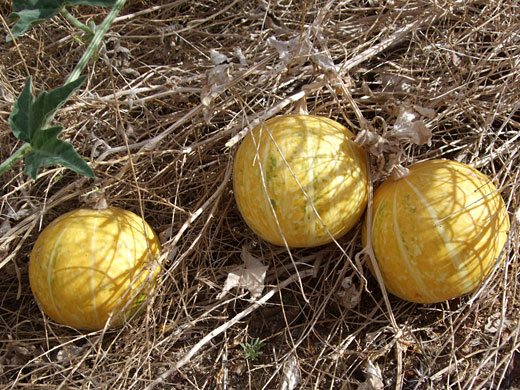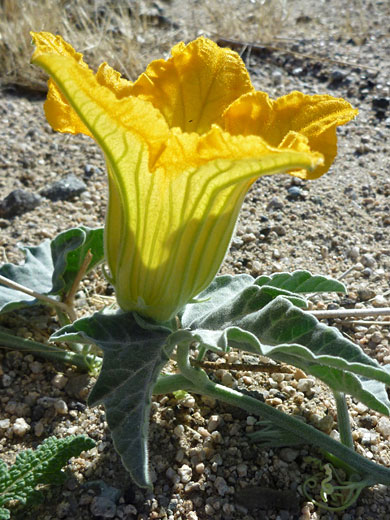Common names:
Coyote melon, coyote gourd
Family:
Scientific name:
Cucurbita palmata
Main flower color:
Range:
South California, the Mojave Desert, and adjoining areas (AZ, CA, NV, UT)
Height:
Stems are up to 4 feet long, but grow close to the ground
Habitat:
Open, arid, sandy locations; up to 4,000 feet
Leaves:
Dark green, palmately cut into five sharply pointed lobes. Up to 5 inches across
Season:
April to June
The cup-shaped flowers of cucurbita palmata are unusually large, up to 3 inches long, opening to four, five or six lobes, which tend to have irregular edges and a few lengthwise grooves. Like all cucurbitaceae species, plants are vines; they grow sideways, the stems along the ground, with large leaves at closely-spaced intervals. Leaves are cordate in outline, but sharply divided (about half way to the central vein) into 4 to 6 lobes, each with a few smaller lobes, or teeth, along the edge. Leaves and flowers have a covering of short, dense hairs.
One flower is produced from each leaf node, and it may contain either stamens or pistils. Nodes also produce a branched tendril. The fruit is a spherical melon, up to 4 inches in diameter, initially dark green with lighter stripes, becoming all yellow as it ripens. Despite its appearance, the fruit is not edible by humans. This is a relatively uncommon species, restricted to arid regions in and around the Mojave Desert.
One flower is produced from each leaf node, and it may contain either stamens or pistils. Nodes also produce a branched tendril. The fruit is a spherical melon, up to 4 inches in diameter, initially dark green with lighter stripes, becoming all yellow as it ripens. Despite its appearance, the fruit is not edible by humans. This is a relatively uncommon species, restricted to arid regions in and around the Mojave Desert.
All Contents © Copyright The American Southwest | Comments and Questions | Contribute | Site Map




